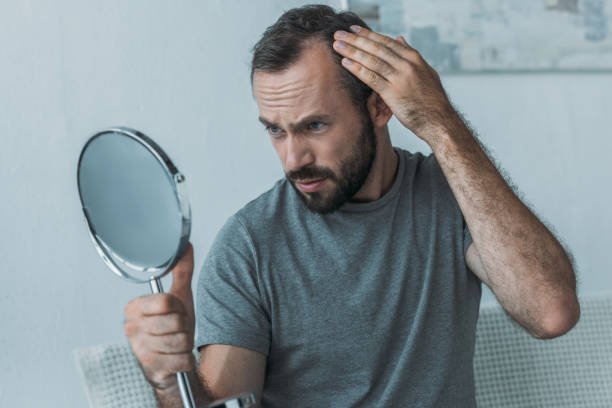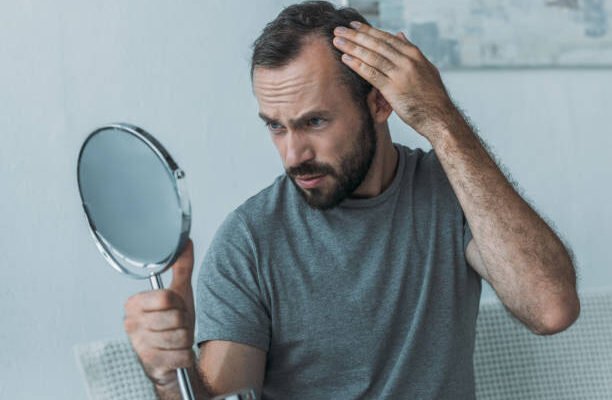Table of Contents
Hair Loss It is an extremely common phenomenon affecting millions of people worldwide. Hair Loss in This may be a very slow gradual process over some years, or it can happen immediately. Hair loss knows no bounds: it can happen to anyone irrespective of his or her age or sex; although the causes, severity, and possible treatments for it do vary from person to person. In this article Hair Loss, we shall discuss different types of hair loss, possible reasons behind hair loss, and how it can be treated.
1. What is Hair Loss?
Hair loss or alopecia means either a thinning or complete loss of hair from the scalp or any other body area. Many do experience it as a normal part of aging, while in some, it may occur due to various reasons, like genetics, health problems, medications, stress, or hormonal changes.
2. Common Causes of Hair Loss
Hair Loss are several ways a person may lose hair. Finding the origin is useful in determining which treatments would work best.
Genetic Factors (Androgenetic Alopecia)
Androgenetic alopecia is the most common condition linked to hair loss, also called male- or female-pattern baldness. It has a genetic basis in both men and women. This condition is characterized by thinning of hair and often diverges to specific bald patterns. In men, this more often leads to a receding hairline or bald spots. Women tend to experience more overall thinning.
Medicinal Conditions with Hormonal Changes
Hormonal changes lead to loss of hair. Temporary or permanent hair loss may arise due to hormonal changes which occur during pregnancy, childbirth, Hair Loss, menopause, thyroid problems, etc. Hormonal imbalances bring about hair thinning and are another possible cause of this condition which is also referred to as polycystic ovary syndrome (pcos).
Nutritional Deficiencies
Hair thinning can commonly result from deficiency in some vital nutrients like iron, vitamin D, and biotin. Poor diet, eating disorders, or malabsorption conditions can deprive the body of essential vitamins and minerals leading to hair loss.
Stress and Trauma
Health and mental stress could be the cause of a certain type of hair loss that is referred to as telogen effluvium. This happens when a large number of hair follicles prematurely fall into the shedding phase causing an observable thinning of hair. Examples of some traumatic events are surgery, Hair Loss death of some close person, and important changes in lifestyle.
Medicines and Treatments
Some medication would usually include chemotherapy drugs, blood thinners used, and antidepressants for high blood pressure, leading to hair loss as side-effects. Mostly, chemotherapy is known to cause temporary hair loss.
Autoimmune Disorders
It is a form of autoimmune disorder in which body immunity targets hair follicles leading to small round patches of loss. Whether alopecia areata occurs suddenly or develops slowly, it can affect any part of the body.
Scalp Infections and Disorders
Hair Loss and Scalp inflammatory infections, like ringworm or other conditions, such as dandruff, psoriasis, and seborrheic dermatitis, cause scalp inflammation and can be a result of hair loss.
Different Types of Hair Loss
Ranging from the types of causes to patterns of hair loss, this hair loss can be classified into several types.
Excessive hair loss caused by chemotherapy or radiation therapy hair changes are generally rapidly growing hair loss cycles when hair begins to fall out.
Excessive hair loss caused by chemotherapy or radiation therapy hair changes are generally rapidly growing hair loss cycles when hair begins to fall out
Treatment of Hair Loss

There are many types of treatments available for addressing hair loss; some can be medical procedures and some can be lifestyle changes.
Over the Counter and prescription medications.
Hair Transplantation
Hair transplant surgery can be one option for severe cases of hair loss, particularly male-pattern baldness. The technique involves harvesting hair follicles from an area of the scalp that has more hair density (usually the back or sides) and transplanting them to areas where hair thinning or balding occurs.
Platelet-Rich Plasma (PRP) Therapy
It involves taking blood from the patient, then processing the blood in a special way to obtain platelets in concentration and injecting this into areas of the scalp where the hair is to stimulate hair growth. Some have found PRP quite effective for cases of androgenetic alopecia and other types of hair loss.
Laser Therapy
Low-level laser therapy (LLLT) uses red light to stimulate hair follicles to promote hair growth. Available devices for such include laser combs or helmets for home use.
Shampoos and topical treatments for hair growth
Certain shampoos can be for hair health in such a way that they prevent further thinning. Most often, the contents are biotin, caffeine, or ketoconazole; these can strengthen hair and inhibit hair loss. Lifestyle and Nutritional Adjustments Improve your diet and rest.
Hair loss is quite a common issue in the present world where men and women share equal space at different stages of their lives. Almost all individuals undergo hair loss, which is natural; nevertheless, loss in bigger amounts may alarm anyone owing to their self-image. By understanding the causes of hair loss, the available treatments, and how to prevent it, anyone can take its beauty back into its own hands.
Alopecia is the other word for hair loss. The condition involves hair falling out at a rate that compromised its normal ability to replace it as though it were growing. Generally, individuals lose 50-100 strands of hair from their heads each day, which is assumed to be within the norms. However, when there are observable signs of thinning patches on a head or bald sections, it may indicate a suspected problem.
Common Causes of Hair Loss
The hair can fall off for many reasons. Some of the common causes are:
Genetics (Androgenetic Alopecia)
This type of hair loss is genetic, the other name of which is male-pattern or female-pattern baldness. It is a form of hereditary hair loss where the hair follicles shrink gradually, resulting in thinner hair that eventually doesn’t grow anymore.
Hormones
Changes in the hormonal milieu can affect the hair cycle and result in loss. Conditions associated with this type of hair loss include: pregnancy, childbirth, menopause, and disorders of the thyroid. Hair fall during and following a pregnancy can also be attributed to changing levels of hormones in a woman’s body.
Medical Conditions
Many medical problems, including but not limited to autoimmune ones like alopecia areata, anemia due to iron deficiency, and infectious agents harbored in the scalp, can also result in hair loss. The immune system misidentifies hair follicles in the case of alopecia areata as within this condition, the body reacts by targeting hair follicles and, so, creates localized loss of hair.
Stress
Physical or emotional stress leads to a phenomenon where the hair adds by telogen effluvium. It is then “prematurely” changed over into the shedding state.
Conclusion:
Hair loss is a result of a wide variety of causes. Genetics, stress, hormonal imbalances, or other factors, knowing what exactly causes it is important for effective management. Hair loss treatments can range from medications to a change in the lifestyle; there are ways to slow down or even reverse the loss now. Right professional guidance will help determine the best approach for you.



